Niche Applications and Flexible Devices for Wave Energy Conversion: A Review
Abstract
:1. Introduction
- Breakwater-integrated WECs;
- Hybrid devices (including hybrid wind–wave and hybrid WEC parks);
- Devices for special applications (including desalination, island microgrids, aquaculture and coastal protection);
- Flexible WECs.
2. Breakwater-Integrated Wecs
2.1. Existing Devices
2.1.1. Oscillating Water Column Wecs
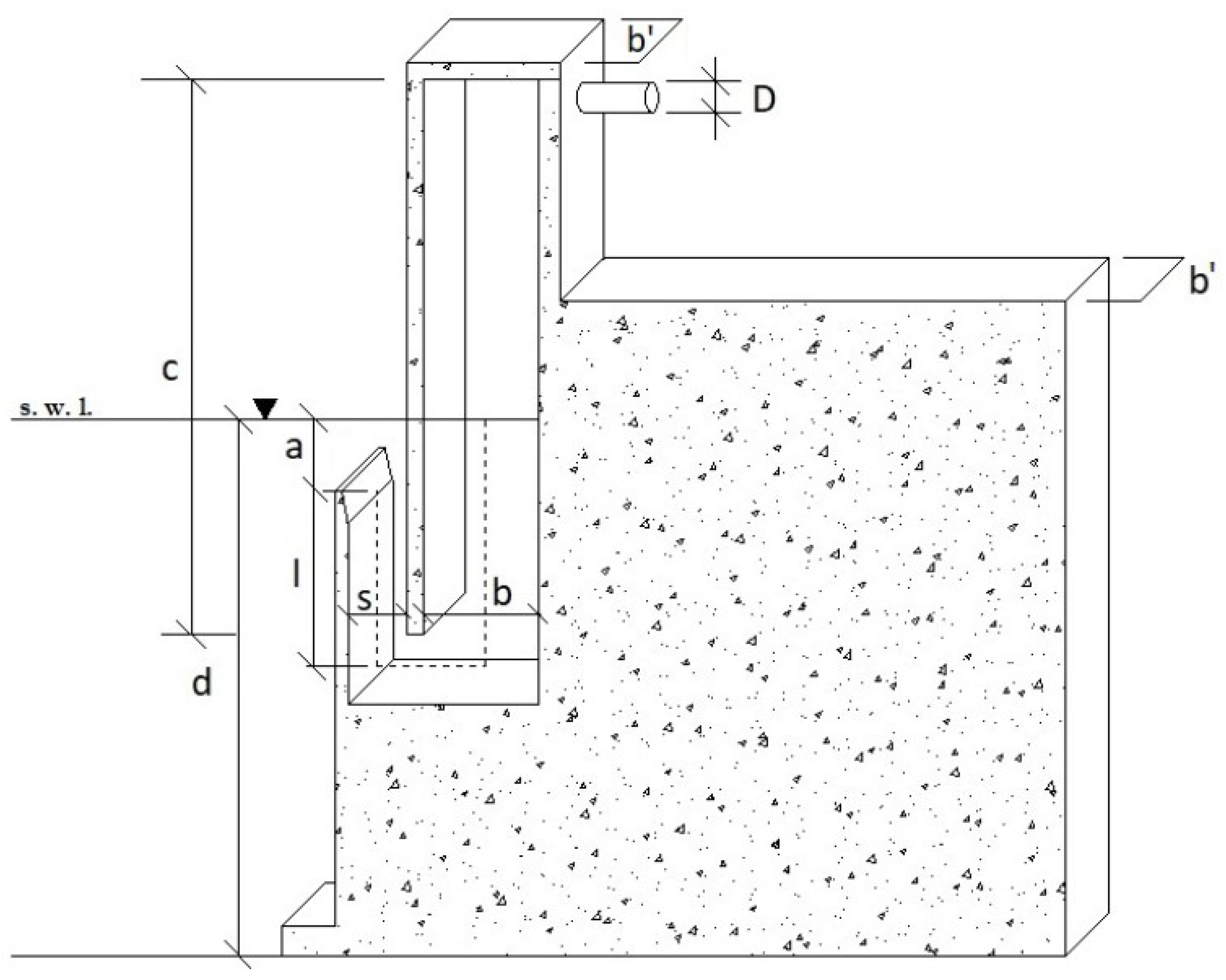
2.1.2. Overtopping Wecs
2.2. Concepts under Development
2.2.1. Wave-Activated Bodies
2.2.2. Multi-Resonant Curved Gates
3. Hybrid Devices
3.1. Existing Concepts
Hybrid Wind–Wave Platforms
3.2. Concepts under Development
3.2.1. Hybrid Wind–Wave
3.2.2. Hybrid Wec Farms
4. Devices for Special Applications
4.1. Offshore and Subsea Applications
4.1.1. Wave-Activated Bodies
4.1.2. Piezoelectric Converters
4.2. Other Applications
4.2.1. Desalination
4.2.2. Island Microgrids
4.2.3. Aquaculture
5. Flexible Devices
5.1. Existing Concepts
5.1.1. Deformable Membranes
5.1.2. Bulge Wave Devices
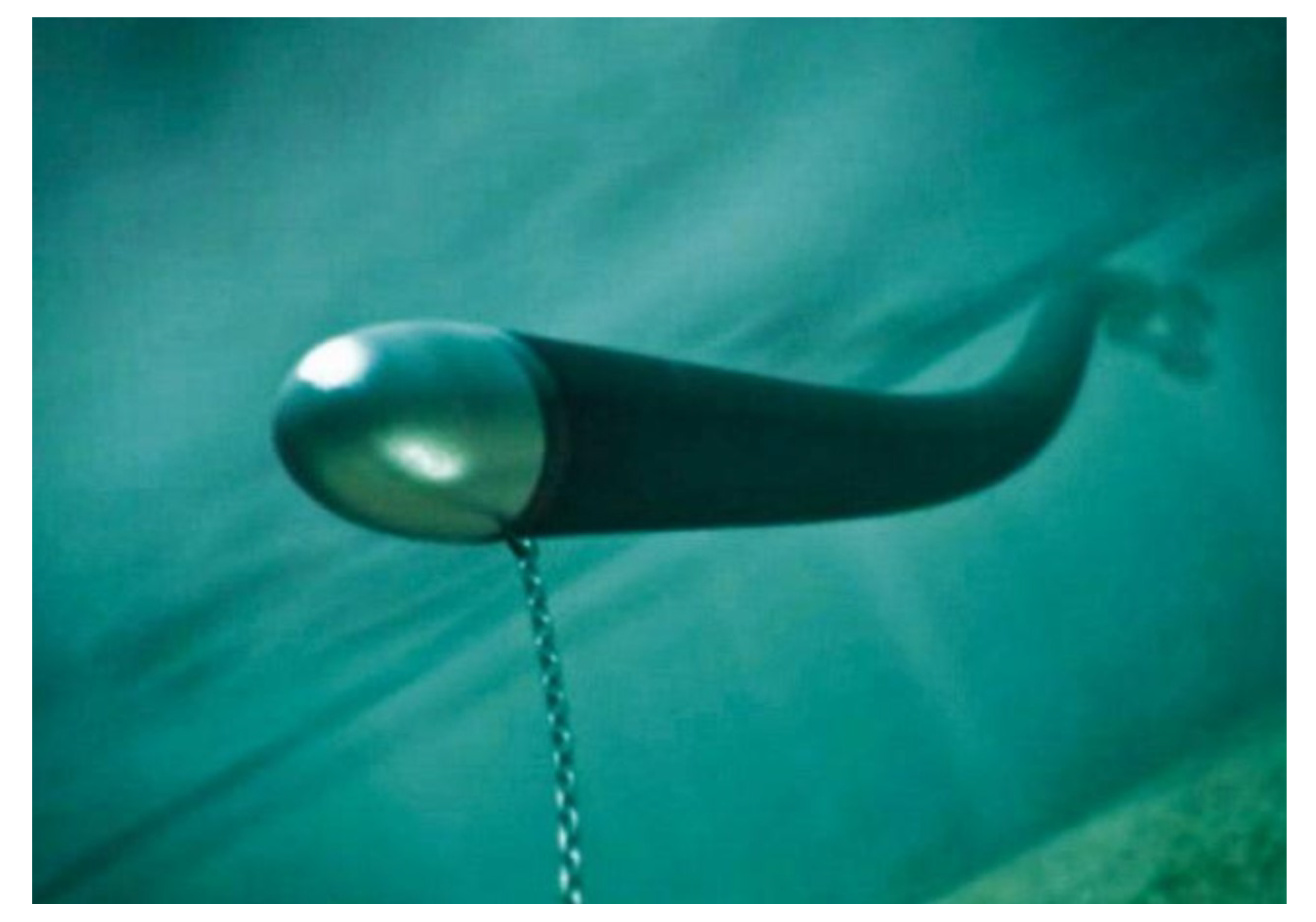
5.1.3. Carpet Membranes
5.2. Concepts under Development
5.2.1. Flexible Air Bag
5.2.2. Flexible Floater
6. Discussion and Conclusions
Author Contributions
Funding
Institutional Review Board Statement
Informed Consent Statement
Data Availability Statement
Conflicts of Interest
Abbreviations
| DEG | Dielectric elastomer generator |
| DM | Deformable membrane |
| EAP | Electro active polymers |
| LCOE | Levelised cost of energy |
| OTD | Overtopping device |
| OWC | Oscillating water column |
| PTO | Power take-off |
| WAB | Wave activated body |
| WEC | Wave energy converter |
References
- Supergen Offshore Renewable Energy. Wave Energy Innovation Position Paper, UK. 2021. Available online: https://supergen-ore.net/uploads/resources/Wave_Energy_Innovation_-_Position_Paper.pdf (accessed on 9 October 2021).
- Jin, S.; Greaves, D. Wave energy in the UK: Status review and future perspectives. Renew. Sustain. Energy Rev. 2021, 143, 110932. [Google Scholar] [CrossRef]
- U.S. Power Sector Is Halfway to Zero Carbon Emissions. Available online: https://newscenter.lbl.gov/2021/04/13/u-s-power-sector-is-halfway-to-zero-carbon-emissions/ (accessed on 20 July 2021).
- Our World in Data. Available online: https://ourworldindata.org/grapher/installed-solar-pv-capacity (accessed on 20 July 2021).
- Greaves, D.; Iglesias, G. Wave and Tidal Energy; Wiley: London, UK, 2018. [Google Scholar]
- Babarit, A. A database of capture width ratio of wave energy converters. Renew. Energy 2015, 80, 610–628. [Google Scholar] [CrossRef] [Green Version]
- Evans, D.V. Wave-power absorption by systems of oscillating surface pressure distributions. J. Fluid Mech. 1982, 114, 481–499. [Google Scholar] [CrossRef]
- Koutrouveli, T.I.; Di Lauro, E.; das Neves, L.; Calheiros-Cabral, T.; Rosa-Santos, P.; Taveira-Pinto, F. Proof of Concept of a Breakwater-Integrated Hybrid Wave Energy Converter Using a Composite Modelling Approach. J. Mar. Sci. Eng. 2021, 9, 226. [Google Scholar] [CrossRef]
- Ning, D.Z.; Zhano, X.L.; Chen, L.F.; Zhao, M. Hydrodynamic Performance of an Array of Wave Energy Converters Integrated with a Pontoon-Type Breakwater. Energies 2018, 11, 685. [Google Scholar] [CrossRef] [Green Version]
- Zhao, X.; Zhang, Y.; Li, M.; Johanning, L. Experimental and analytical investigation on hydrodynamic performance of the comb-type breakwater-wave energy converter system with a flange. Renew. Energy 2021, 172, 392–407. [Google Scholar] [CrossRef]
- Sarkar, D.; Renzi, E.; Dias, F. Effect of a straight coast on the hydrodynamics and performance of the Oscillating Wave Surge Converter. Ocean Eng. 2015, 105, 25–32. [Google Scholar] [CrossRef] [Green Version]
- Buriani, F.; Renzi, E. Hydrodynamics of a Flexible Piezoelectric Wave Energy Harvester Moored on a Breakwater. In Proceedings of the 12th European Wave and Tidal Energy Conference (EWTEC 2017), Cork, Ireland, 27 August–1 September 2017. [Google Scholar]
- Vicinanza, D.; Di Lauro, D.; Contestabile, P.; Gisonni, C.; Lara, J.L.; Losada, I.J. Review of Innovative Harbor Breakwaters for Wave-Energy Conversion. J. Waterw. Port Coast. Ocean Eng. 2019, 145, 03119001. [Google Scholar] [CrossRef]
- Power Technology. Available online: https://www.power-technology.com/projects/mutriku-wave/ (accessed on 5 July 2021).
- Garrido, A.J.; Otaola, E.; Garrido, I.; Lekube, J.; Maseda, F.J.; Liria, P.; Mader, J. Mathematical Modeling of Oscillating Water Columns Wave-Structure Interaction in Ocean Energy Plants. Math. Probl. Eng. 2015, 2015, 727982. [Google Scholar] [CrossRef] [Green Version]
- McCormick, M.E. Ocean Wave Energy Conversion; Wiley Interscience: New York, NY, USA, 1981. [Google Scholar]
- Falcao, A.F.O.; Henriques, J.C.C. Oscillating-water-column wave energy converters and air turbines: A review. Renew. Energy 2016, 85, 1391–1424. [Google Scholar] [CrossRef]
- Babarit, A. Ocean Wave Energy Conversion; Elsevier: Amsterdam, The Netherlands, 2018. [Google Scholar]
- Boccotti, P. Comparison between a U-OWC and a conventional OWC. Ocean Eng. 2007, 34, 799–805. [Google Scholar] [CrossRef]
- Strati, F.M.; Malara, G.; Arena, F. Performance optimization of a U-Oscillating-Water-Column wave energy harvester. Renew. Energy 2016, 99, 1019–1028. [Google Scholar] [CrossRef]
- Malara, G.; Romolo, A.; Fiamma, V.; Arena, F. On the modelling of water column oscillations in U-OWC energy harvesters. Renew. Energy 2017, 101, 964–972. [Google Scholar] [CrossRef]
- Ning, D.; Guo, B.; Wang, R.; Vyzikas, T.; Greaves, D. Geometrical investigation of a U-shaped oscillating water column wave energy device. Appl. Ocean Res. 2020, 97, 102105. [Google Scholar] [CrossRef]
- Gurnari, L.; Filianoti, P.G.F.; Torresi, M.; Camporeale, S.M. The Wave-to-Wire Energy Conversion Process for a Fixed U-OWC Device. Energies 2020, 13, 283. [Google Scholar] [CrossRef] [Green Version]
- Arena, F.; Fiamma, V.; Laface, V.; Malara, G.; Romolo, A.; Viviano, A.; Sannino, G.; Carillo, A. Installing U-OWC devices along Italian coasts. In Proceedings of the ASME 2013 32nd International Conference on Ocean Offshore and Arctic Engineering (OMAE2013), Nantes, France, 9–14 June 2013. [Google Scholar]
- Arena, F.; Romolo, A.; Malara, G.; Fiamma, V.; Laface, V. The first full operative U-OWC plants in the port of Civitavecchia. In Proceedings of the ASME 2017 36th International Conference on Ocean, Offshore and Arctic Engineering (OMAE2017), Trondheim, Norway, 25–30 June 2017. [Google Scholar]
- Moretti, G.; Malara, G.; Scialó, A.; Daniele, L.; Romolo, A.; Vertechy, R.; Fontana, M.; Arena, F. Modelling and field testing of a breakwater-integrated U-OWC wave energy converter with dielectric elastomer generator. Renew. Energy 2020, 146, 628–642. [Google Scholar] [CrossRef]
- Vicinanza, D.; Nørgaard, J.H.; Contestabile, P.; Andersen, T.L. Wave loadings acting on overtopping breakwater for energy conversion. J. Coast. Res. 2013, 65, 1669–1674. [Google Scholar] [CrossRef]
- Vicinanza, D.; Contestabile, P.; Nørgaard, J.; Lykke-Andersen, T. Innovative rubble mound breakwaters for overtopping wave energy conversion. Coast. Eng. 2014, 88, 154–170. [Google Scholar] [CrossRef]
- Contestabile, P.; Iuppa, C.; Di Lauro, E.; Cavallaro, L.; Andersen, T.L.; Vicinanza, D. Wave loadings acting on innovative rubble mound breakwater for overtopping wave energy conversion. Coast. Eng. 2017, 122, 60–74. [Google Scholar] [CrossRef]
- Contestabile, P.; Crispino, G.; Di Lauro, E.; Ferrante, V.; Gisonni, C.; Vicinanza, D. Overtopping breakwater for wave Energy Conversion: Review of state of art, recent advancements and what lies ahead. Renew. Energy 2020, 147, 705–718. [Google Scholar] [CrossRef]
- Iuppa, C.; Contestabile, P.; Cavallaro, L.; Foti, E.; Vicinanza, D. Hydraulic Performance of an Innovative Breakwater for Overtopping Wave Energy Conversion. Sustainability 2016, 8, 1226. [Google Scholar] [CrossRef] [Green Version]
- Cascajo, R.; García, E.; Quiles, E.; Correcher, A.; Morant, F. Integration of Marine Wave Energy Converters into Seaports: A Case Study in the Port of Valencia. Energies 2019, 12, 787. [Google Scholar] [CrossRef] [Green Version]
- Cabral, T.; Clemente, D.; Rosa-Santos, P.; Taveira-Pinto, F.; Morais, T.; Belga, F.; Cestaro, H. Performance Assessment of a Hybrid Wave Energy Converter Integrated into a Harbor Breakwater. Energies 2020, 13, 236. [Google Scholar] [CrossRef] [Green Version]
- Calheiros-Cabral, T.; Clemente, D.; Rosa-Santos, P.; Taveira-Pinto, F.; Ramos, V.; Morais, T.; Cestaro, H. Evaluation of the annual electricity production of a hybrid breakwater-integrated wave energy converter. Energy 2020, 213, 118845. [Google Scholar] [CrossRef]
- Michele, S.; Renzi, E.; Sammarco, P. Weakly nonlinear theory for a gate-type curved array in waves. J. Fluid Mech. 2019, 869, 238–263. [Google Scholar] [CrossRef] [Green Version]
- Renzi, E.; Dias, F. Motion-resonant modes of large articulated damped oscillators in waves. J. Fluid Struct. 2014, 49, 705–715. [Google Scholar] [CrossRef] [Green Version]
- Michele, S.; Renzi, E. A second-order theory for an array of curved wave energy converters in open sea. J. Fluid Struct. 2019, 88, 315–330. [Google Scholar] [CrossRef]
- Renzi, E.; Dias, F. Resonant behaviour of an oscillating wave energy converter in a channel. J. Fluid Mech. 2012, 701, 482–510. [Google Scholar] [CrossRef] [Green Version]
- Renzi, E.; Dias, F. Hydrodynamics of the oscillating wave surge converter in the open ocean. Eur. J. Mech. (B/Fluids) 2013, 41, 1–10. [Google Scholar] [CrossRef] [Green Version]
- Renzi, E.; Abdolali, A.; Bellotti, G.; Dias, F. Wave-power absorption from a finite array of oscillating wave surge converters. Renew. Energy 2014, 63, 55–68. [Google Scholar] [CrossRef] [Green Version]
- Pérez-Collazo, C.; Greaves, D.; Iglesias, G. A review of combined wave and offshore wind energy. Renew. Sustain. Energy Rev. 2015, 42, 141–153. [Google Scholar] [CrossRef] [Green Version]
- Hu, J.; Zhou, B.; Vogel, C.; Liu, P.; Willden, R.; Sun, K.; Zang, J.; Geng, J.; Jin, P.; Cui, L.; et al. Optimal design and performance analysis of a hybrid system combing a floating wind platform and wave energy converters. Appl. Energy 2020, 269, 114998. [Google Scholar] [CrossRef]
- Talaat, M.; Farahat, M.A.; Elkholy, M.H. Renewable power integration: Experimental and simulation study to investigate the ability of integrating wave, solar and wind energies. Energy 2019, 170, 668–682. [Google Scholar] [CrossRef]
- McTiernan, K.L.; Sharman, K.T. Review of Hybrid Offshore Wind and Wave Energy Systems. J. Phys. Conf. Ser. 2020, 1452, 012016. [Google Scholar] [CrossRef]
- Yde, A.; Larsen, T.J.; Hansen, A.M.; Fernandez, M.; Bellew, S. Comparison of Simulations and Offshore Measurement Data of a Combined Floating Wind and Wave Energy Demonstration Platform. J. Ocean. Wind Energy 2015, 2, 129–137. [Google Scholar] [CrossRef]
- Floating Power Plant. Available online: https://www.floatingpowerplant.com/ (accessed on 7 July 2021).
- W2Power. Available online: http://www.pelagicpower.no/ (accessed on 13 July 2021).
- Legaz, M.J.; Coronil, D.; Mayorga, P.; Fernandez, J. Study of a hybrid renewable energy platform: W2Power. In Proceedings of the ASME 2018 37th International Conference on Ocean, Offshore and Arctic Engineering OMAE2018, Madrid, Spain, 17–22 June 2018. [Google Scholar]
- Michele, S.; Renzi, E.; Perez-Collazo, C.; Greaves, D.; Iglesias, G. Power extraction in regular and random waves from an OWC in hybrid wind–wave energy systems. Ocean Eng. 2019, 191, 106519. [Google Scholar] [CrossRef]
- Perez-Collazo, C.; Greaves, D.; Iglesias, G. Hydrodynamic response of the WEC sub-system of a novel hybrid wind–wave energy converter. Energy Convers. Manag. 2018, 171, 307–325. [Google Scholar] [CrossRef]
- Perez-Collazo, C.; Greaves, D.; Iglesias, G. A novel hybrid wind–wave energy converter for jacket frame substructures. Energies 2018, 11, 637. [Google Scholar] [CrossRef] [Green Version]
- Integrated Semi-Submersible Platform with Innovative Renewable Energy. Available online: https://www.inspireoffshoreenergy.com/ (accessed on 19 July 2021).
- Harnessing Waves and Wind. Available online: https://www.marinepowersystems.co.uk/dualsub/ (accessed on 4 September 2021).
- Sarkar, D.; Renzi, E.; Dias, F. Interactions Between an Oscillating Wave Surge Converter and a Heaving Wave Energy Converter. J. Ocean Wind Energy 2014, 1, 135–142. [Google Scholar]
- Göteman, M.; Giassi, M.; Engström, J.; Isberg, J. Advances and Challenges in Wave Energy Park Optimization—A Review. Front. Energy Res. 2020, 8, 26. [Google Scholar] [CrossRef] [Green Version]
- Ocean Power Technologies. Available online: https://oceanpowertechnologies.com/oil-gas-2/ (accessed on 19 July 2021).
- ISWEC: Energy from the Sea. Available online: https://www.eni.com/en-IT/operations/iswec-eni.html (accessed on 19 July 2021).
- Wave Energy Converter. Available online: https://www.mocean.energy/wave-energy-converter/ (accessed on 19 July 2021).
- Wu, N.; Wang, Q.; Xie, X.D. Ocean wave energy harvesting with a piezoelectric coupled buoy structure. Appl. Ocean Res. 2015, 50, 110–118. [Google Scholar] [CrossRef]
- Mutsuda, H.; Watanabe, R.; Azuma, S.; Tanaka, Y.; Doi, Y. Ocean Power Generator Using Flexible Piezoelectric Device. In Proceedings of the ASME 2013 32nd International Conference on Ocean, Offshore and Arctic Engineering OMAE2013, Nantes, France, 9–14 June 2013. [Google Scholar]
- Tanaka, Y.; Oko, T.; Mutsuda, H.; Patel, R.; McWilliam, S.; Popov, A. An experimental study of wave power generation using a flexible piezoelectric device. J. Ocean Wind Energy 2015, 2, 28–36. [Google Scholar]
- Renzi, E. Hydroelectromechanical modelling of a piezoelectric wave energy converter. Proc. R. Soc. A 2016, 472, 20160715. [Google Scholar] [CrossRef] [Green Version]
- Jbaily, A.; Yeung, R.W. Piezoelectric devices for ocean energy: A brief survey. J. Ocean Eng. Mar. Energy 2015, 1, 101–118. [Google Scholar] [CrossRef] [Green Version]
- Kiran, M.R.; Farrok, O.; Abdullah-Al-Mamun, M.; Islam, M.R.; Xu, W. Progress in Piezoelectric Material Based Oceanic Wave Energy Conversion Technology. IEEE Access 2020, 8, 146428–146449. [Google Scholar] [CrossRef]
- Zheng, S.; Meylan, M.; Zhang, X.; Iglesias, G.; Greaves, D. Performance of a plate-wave energy converter integrated in a floating breakwater. Renew. Power Gener. 2021, 1–14. [Google Scholar] [CrossRef]
- Zheng, S.; Greaves, D.; Meylan, H.M.; Iglesias, G. Wave power extraction by a submerged piezoelectric plate. In Proceedings of the 4th International Conference on Renewable Energies Offshore (RENEW2020), Lisbon, Portugal, 12–15 October 2020. [Google Scholar]
- Mutsuda, H.; Tanaka, Y.; Patel, R.; Doi, Y.; Moriyama, Y. A painting type of flexible piezoelectric device for ocean energy harvesting. Appl. Ocean Res. 2017, 68, 182–193. [Google Scholar] [CrossRef]
- CETO Wave-Powered Desalination Pilot Plant, Garden Island. Available online: https://www.water-technology.net/projects/ceto-wave-powered-desalination-pilot-plant-garden-island/ (accessed on 19 July 2021).
- Franzitta, V.; Curto, D.; Milone, D.; Viola, A. The Desalination Process Driven by Wave Energy: A Challenge for the Future. Energies 2016, 9, 1032. [Google Scholar] [CrossRef] [Green Version]
- Remote Tasmanian Island to Be Powered by ‘Blowhole’ Energy That Harnesses Waves. Available online: https://www.theguardian.com/australia-news/2021/feb/02/remote-tasmanian-island-to-be-powered-by-blowhole-energy-that-harnesses-waves (accessed on 5 September 2021).
- Wave Swell Energy. Available online: https://www.waveswell.com/ (accessed on 5 September 2021).
- Wave Swell Energy’s UniWave200 Is Installed at King Island. Available online: https://www.waveswell.com/king-island/wave-swell-energys-uniwave200-is-installed-at-king-island/ (accessed on 19 July 2021).
- Wave Powered Coral Reef Creation. Available online: https://www.ccell.co.uk/index.php (accessed on 19 July 2021).
- Moretti, G.; Rosati Papini, G.P.; Daniele, L.; Forehand, D.; Ingram, D.; Vertechy, R.; Fontana, M. Modelling and testing of a wave energy converter based on dielectric elastomer generators. Proc. R. Soc. A 2019, 475, 20180566. [Google Scholar] [CrossRef] [Green Version]
- Moretti, G.; Rosset, S.; Vertechy, R.; Anderson, I.; Fontana, M. A Review of Dielectric Elastomer Generator Systems. Adv. Intell. Syst. 2020, 2, 2000125. [Google Scholar] [CrossRef]
- Projects to Unlock the Potential of Marine Wave Energy. Available online: https://www.ukri.org/news/projects-to-unlock-the-potential-of-marine-wave-energy/ (accessed on 2 September 2021).
- Collins, I.; Hossain, M.; Masters, I. A review of flexible membrane structures for Wave Energy Converters. In Proceedings of the 13th European Wave and Tidal Energy Conference (EWTEC 2019), Naples, Italy, 1–6 September 2019. [Google Scholar]
- Collins, I.; Hossain, M.; Dettmer, W.G.; Masters, I. Flexible membrane structures for wave energy harvesting: A review of the developments, materials and computational modelling approaches. Renew. Sustain. Energy Rev. 2021, 151, 111458. [Google Scholar] [CrossRef]
- AWS Ocean Energy. Available online: https://www.awsocean.com/research-development/ (accessed on 14 July 2021).
- mWave. Available online: https://bomborawave.com/mwave/ (accessed on 14 July 2021).
- Algie, C.; Fleming, A.; Ryan, S. Experimental and Numerical Modelling of the Bombora Wave Energy Converter. In Proceedings of the 3rd Asian Wave and Tidal Energy Conference (AWTEC 2016), Singapore, 25–27 October 2016. [Google Scholar]
- Algie, C.; Ryan, S.; Fleming, A. Predicted power performance of a submerged membrane pressure-differential wave energy converter. Int. J. Mar. Energy 2017, 20, 125–134. [Google Scholar] [CrossRef]
- Farley, F.J.M.; Rainey, R.C.T.; Chaplin, J.R. Rubber tubes in the sea. Philos. T. R. Soc. A 2012, 370, 381–402. [Google Scholar] [CrossRef]
- Mei, C.C. Nonlinear resonance in Anaconda. J. Fluid Mech. 2014, 750, 507–517. [Google Scholar] [CrossRef]
- Heller, V.; Chaplin, J.R.; Farley, F.J.M.; Hann, M.R.; Hearn, G.E. Physical model tests of the anaconda wave energy converter. In Proceedings of the 1st IAHR European Congress, Edinburgk, UK, 4–6 May 2010. [Google Scholar]
- Chaplin, J.R.; Heller, V.; Farley, F.J.M.; Hearn, G.E.; Rainey, R.C.T. Laboratory testing the Anaconda. Philos. T. R. Soc. A 2012, 370, 403–424. [Google Scholar] [CrossRef] [PubMed]
- Smith, W.R. Wave-structure interactions for the distensible tube wave energy converter. Proc. R. Soc. A 2016, 472, 20160160. [Google Scholar] [CrossRef] [Green Version]
- Anaconda Left Languishing by Wave Energy Scotland. Available online: https://www.checkmateukseaenergy.com/anaconda-left-languishing-by-wave-energy-scotland/ (accessed on 15 July 2021).
- Jean, P.; Wattez, A.; Ardoise, G.; Melis, C.; Van Kessel, R.; Fourmon, A.; Barrabino, E.; Heemskerk, J.; Queau, J.P. Standing wave tube electro active polymer wave energy converter. In Proceedings of the SPIE 8340, Electroactive Polymer Actuators and Devices (EAPAD), San Diego, CA, USA, 12–15 March 2012; p. 83400C. [Google Scholar]
- Babarit, A.; Singh, J.; Melis, C.; Wattez, A.; Jean, P. A linear numerical model for analysing the hydroelastic response of a flexible electroactive wave energy converter. J. Fluid Struct. 2017, 74, 356–384. [Google Scholar] [CrossRef] [Green Version]
- Ancellin, M.; Dong, M.; Jean, P.; Dias, F. Far-Field Maximal Power Absorption of a Bulging Cylindrical Wave Energy Converter. Energies 2020, 13, 5499. [Google Scholar] [CrossRef]
- Alam, M.-R. Nonlinear analysis of an actuated seafloor-mounted carpet for a high-performance wave energy extraction. Proc. R. Soc. A 2012, 468, 3153–3171. [Google Scholar] [CrossRef]
- Lehmann, M.; Elandt, R.; Pham, H.; Ghorbani, R.; Shakeri, M.; Alam, M.-R. An artificial seabed carpet for multidirectional and broadband wave energy extraction: Theory and Experiment. In Proceedings of the 10th European Wave & Tidal Energy Conference, EWTEC2013, Aalborg, Denmark, 2–5 September 2013. [Google Scholar]
- Lehmann, M.; Elandt, R.; Shakeri, M.; Alam, R. TheWave Carpet: Development of a Submerged Pressure DifferentialWave Energy Converter. In Proceedings of the 30th Symposium on Naval Hydrodynamics, Hobart, Tasmania, Australia, 2–7 November 2014. [Google Scholar]
- DOE Announces $24.9 Million Funding Selections to Advance Hydropower and Water Technologies. Available online: https://www.energy.gov/articles/doe-announces-249-million-funding-selections-advance-hydropower-and-water-technologies (accessed on 15 July 2021).
- Greaves, D.; Hann, M.; Kurniawan, A.; Chaplin, J.; Farley, F. The Hydrodynamics of Air-Filled Bags for Wave Energy Conversion. In Proceedings of the International Conference on Offshore Renewable Energy, Glasgow, UK, 12–14 September 2016. [Google Scholar]
- Kurniawan, A.; Chaplin, J.R.; Greaves, D.M.; Hann, M. Wave energy absortption by a floating air bag. J. Fluid Mech. 2017, 812, 294–320. [Google Scholar] [CrossRef] [Green Version]
- Michele, S.; Buriani, F.; Renzi, E.; van Rooij, M.; Jayawardhana, B.; Vakis, A.I. Wave Energy Extraction by Flexible Floaters. Energies 2020, 13, 6167. [Google Scholar] [CrossRef]
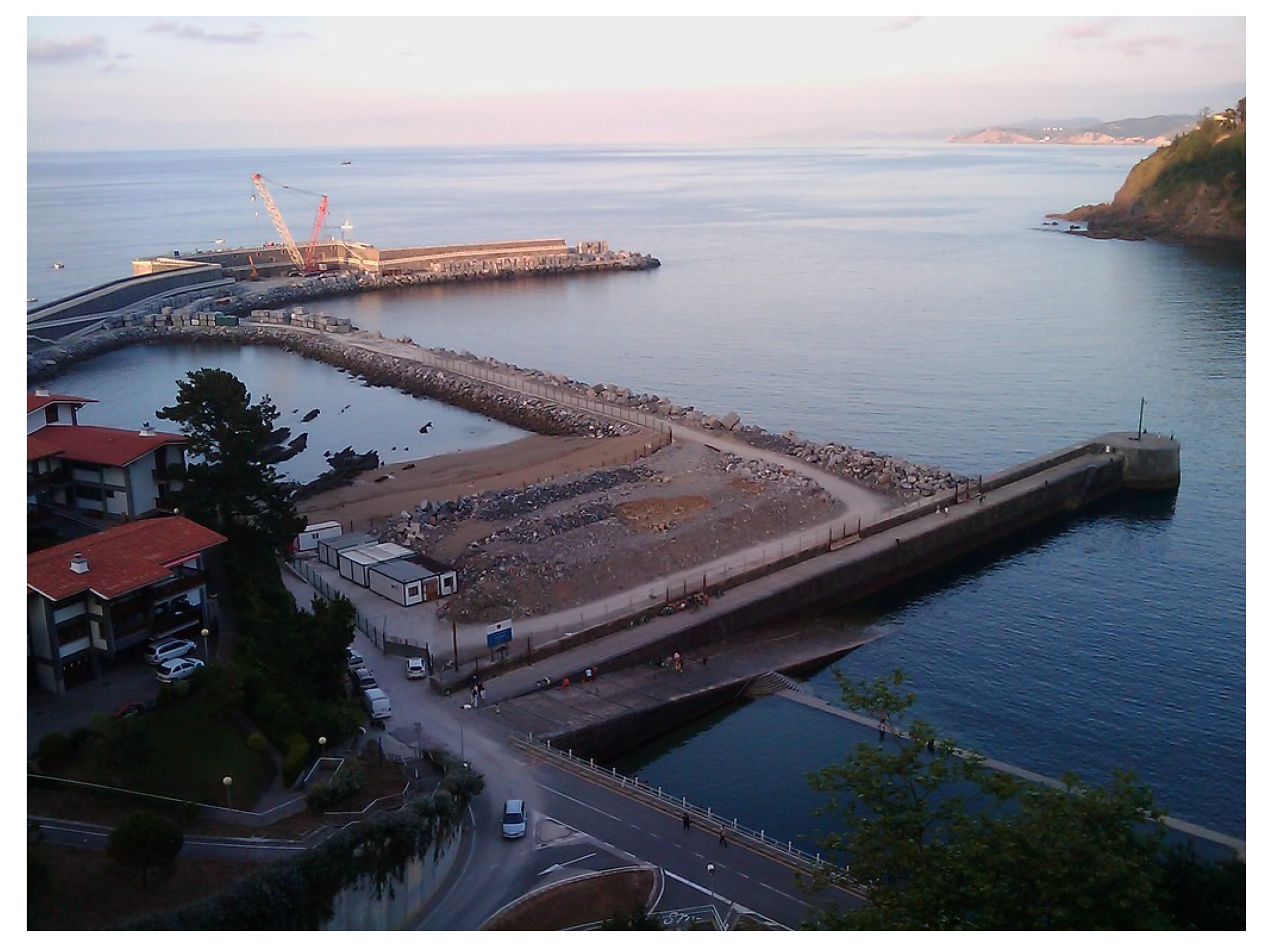
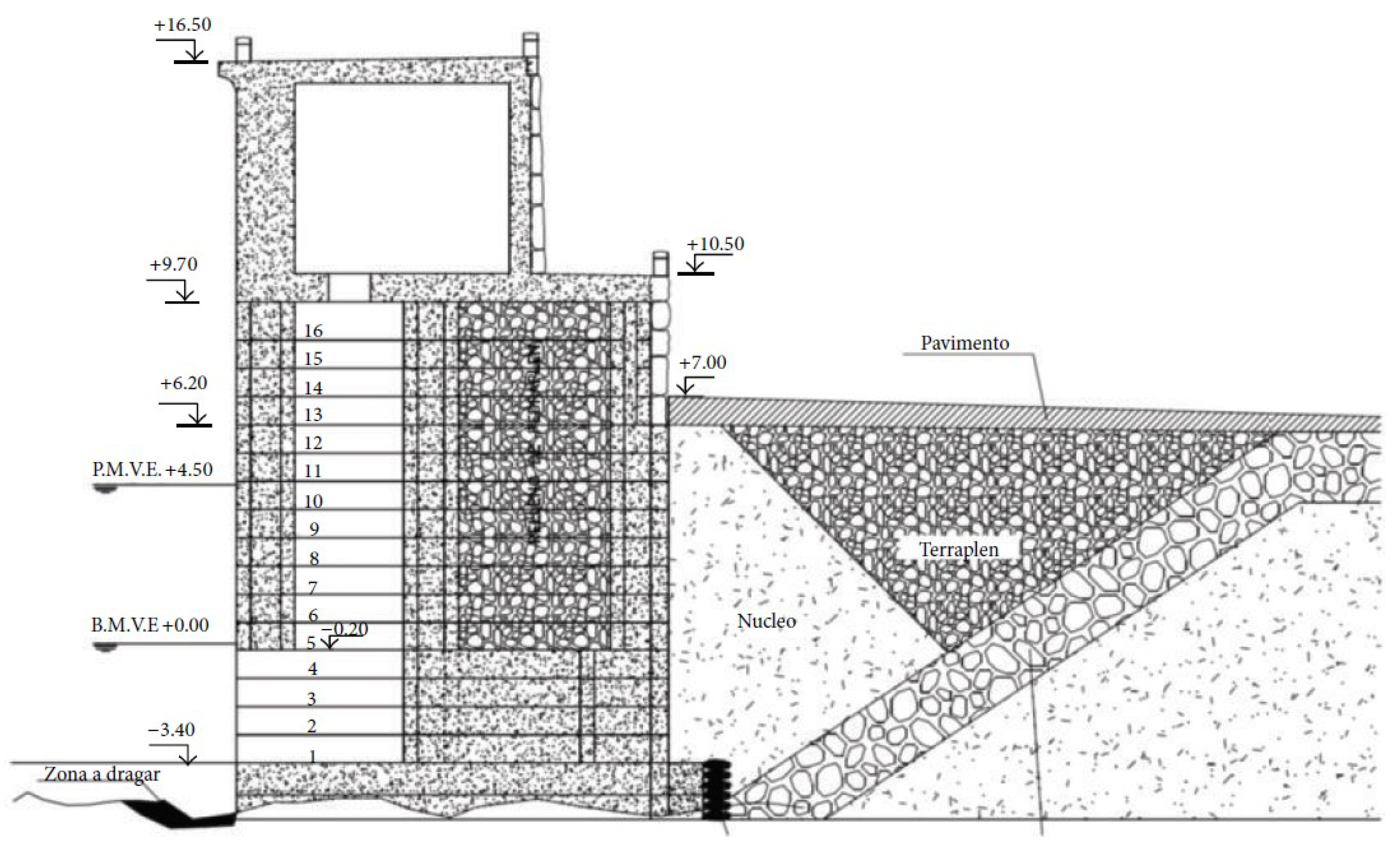

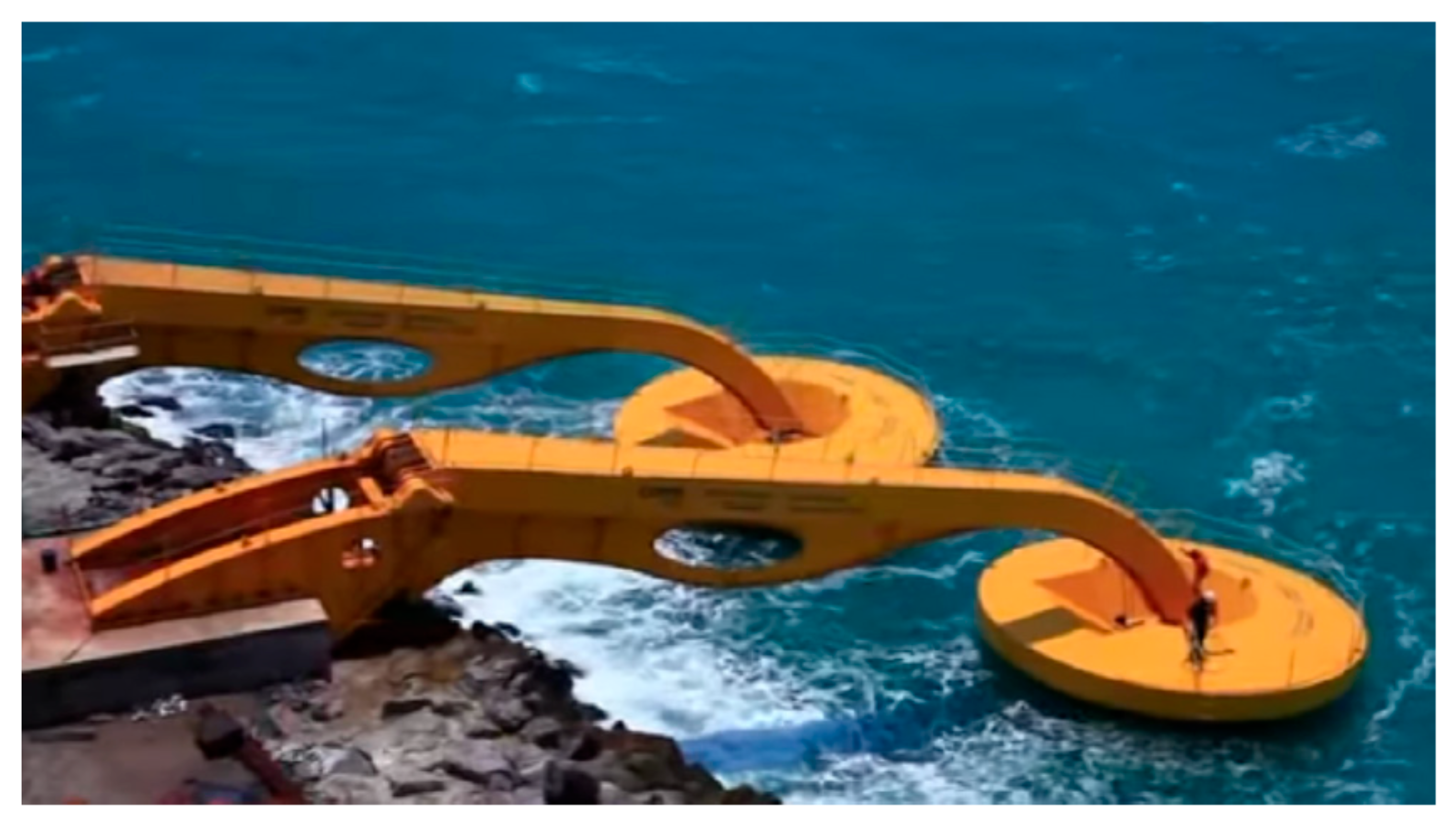
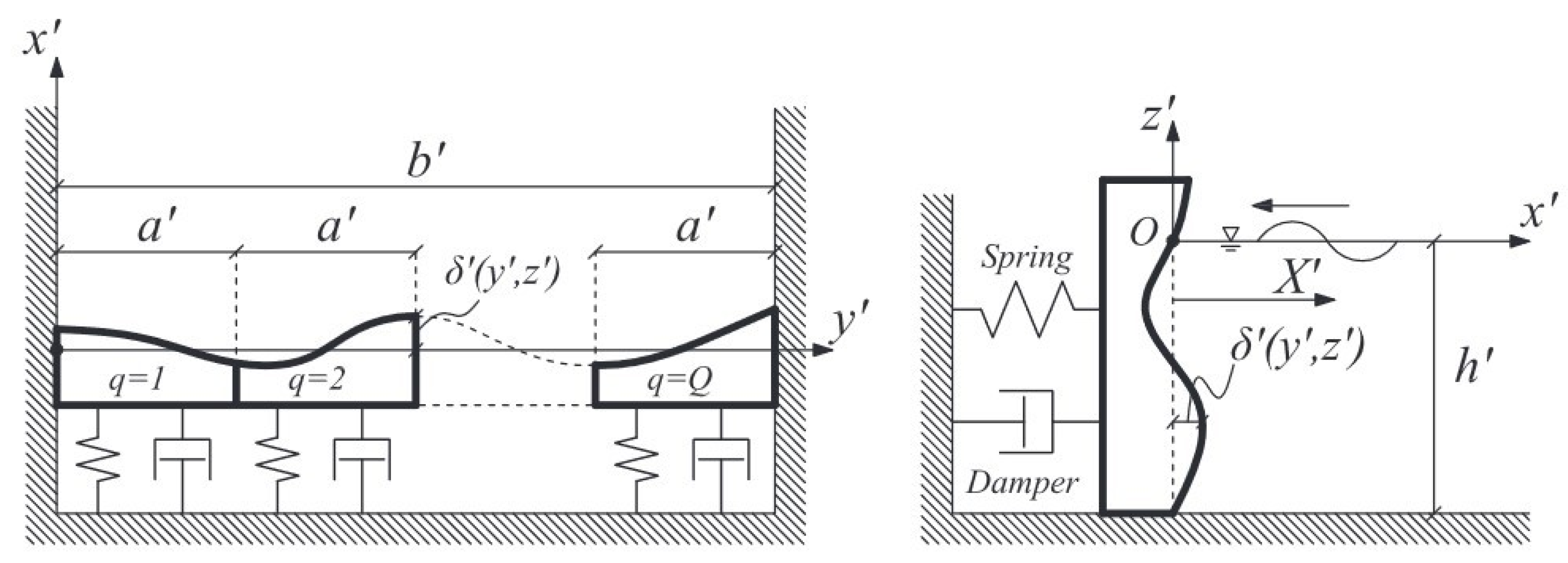
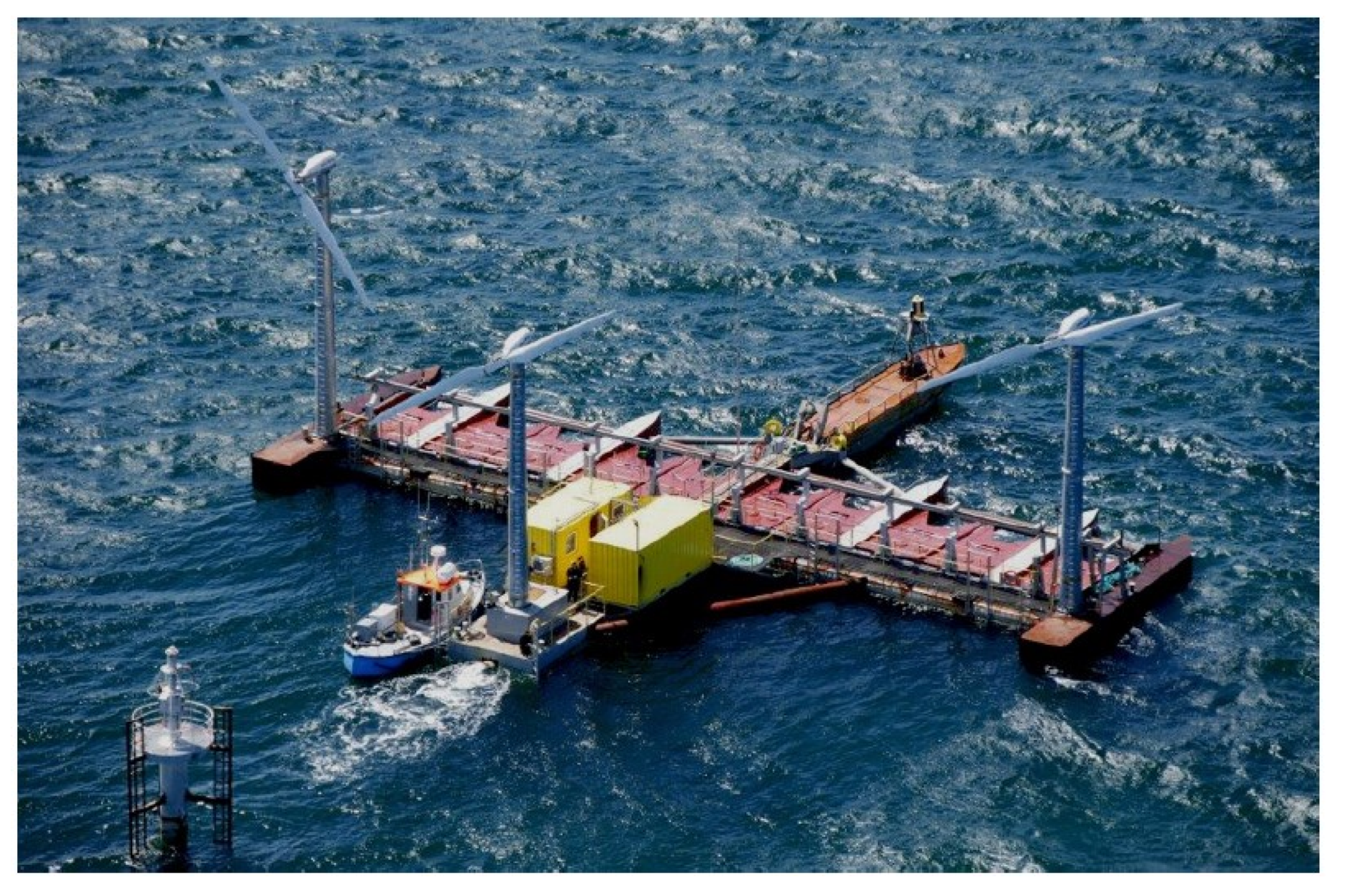
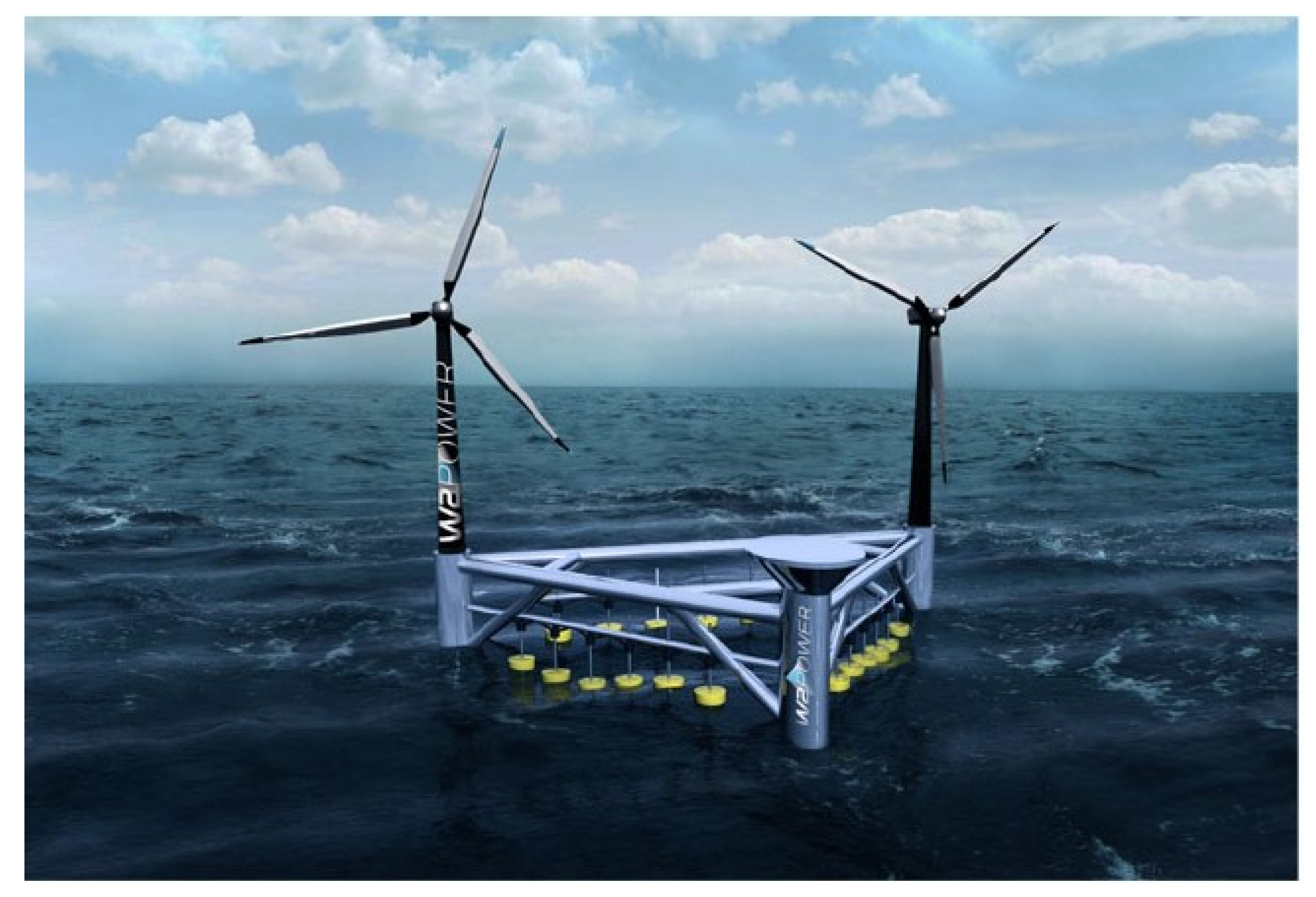
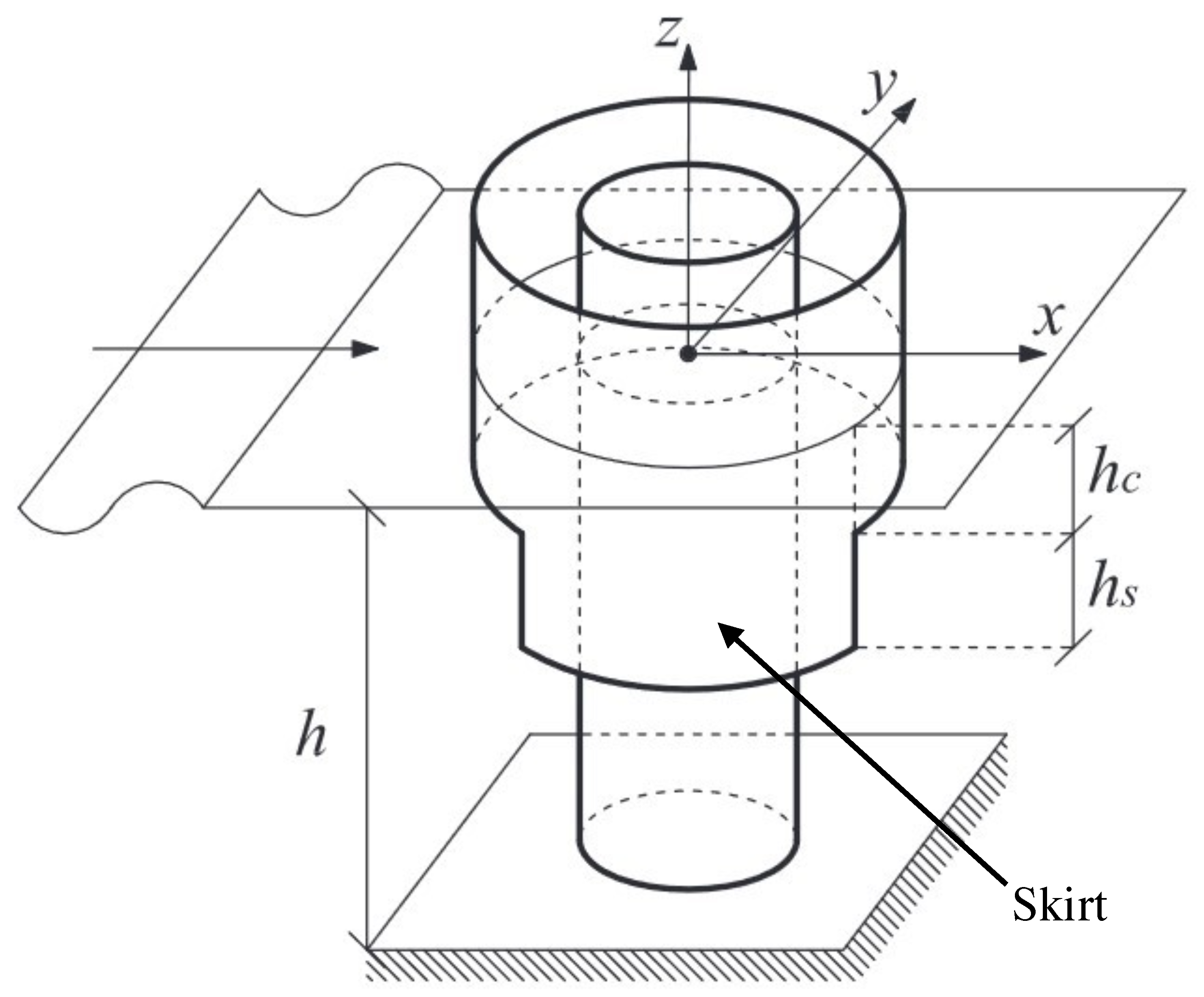
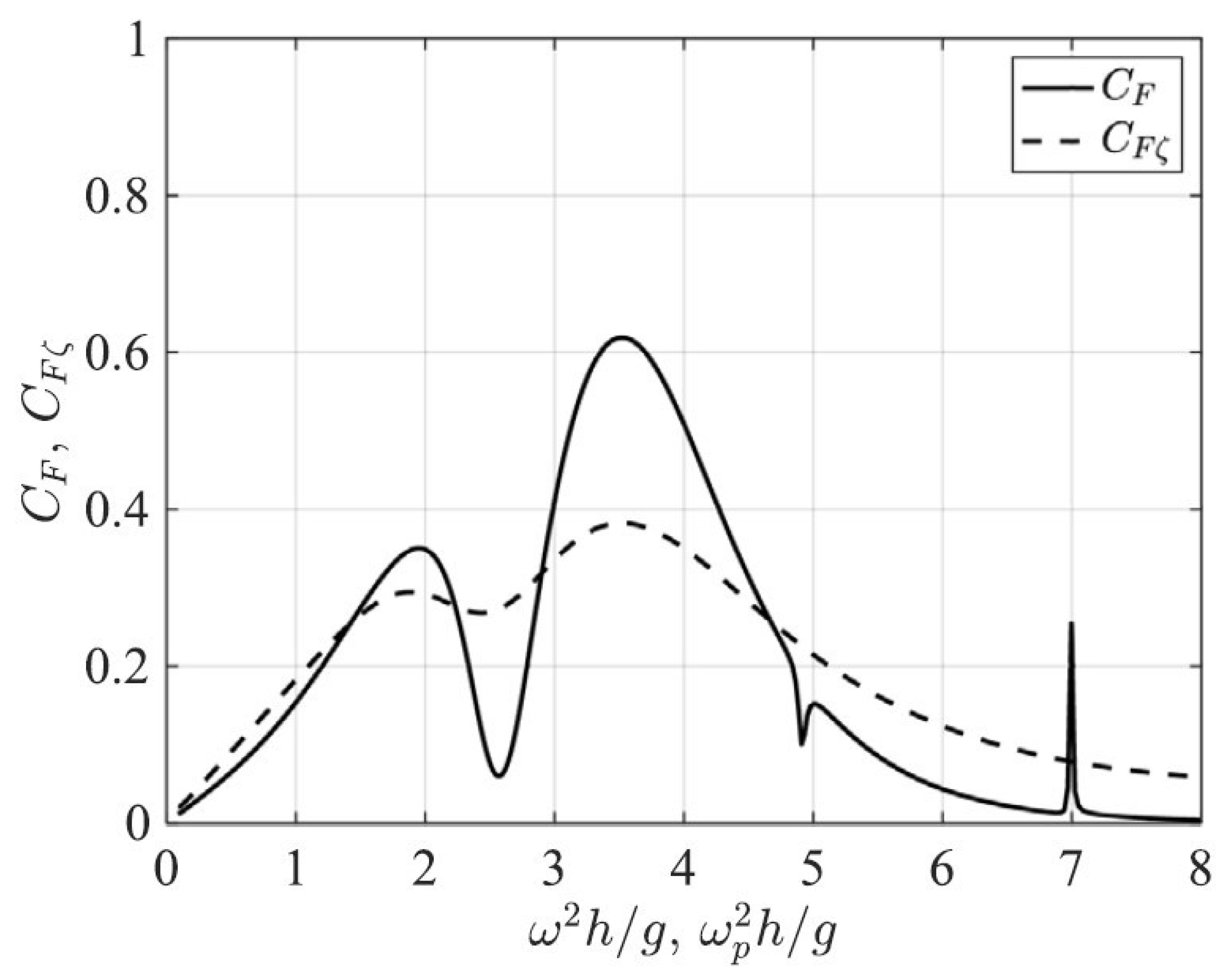

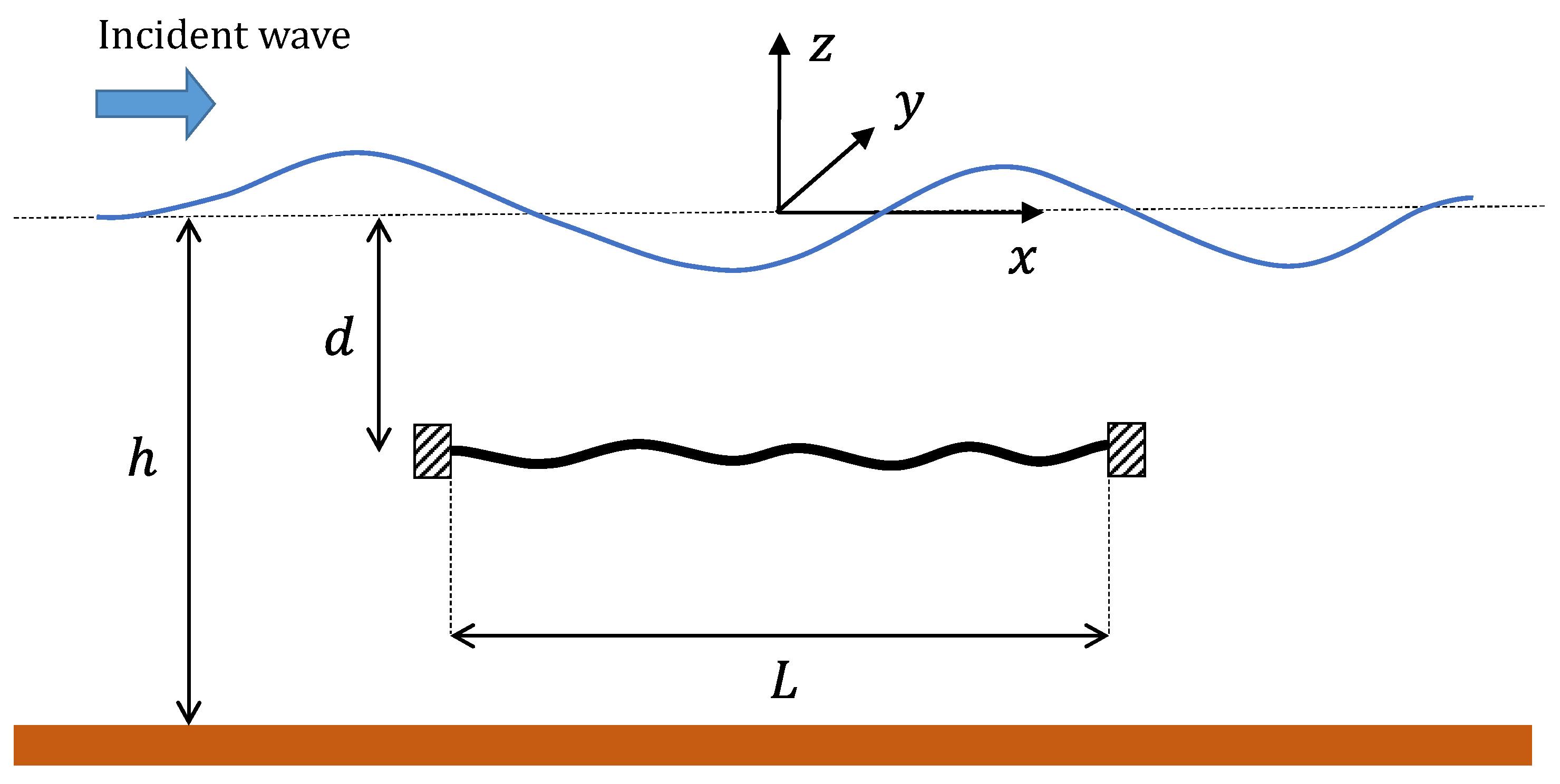
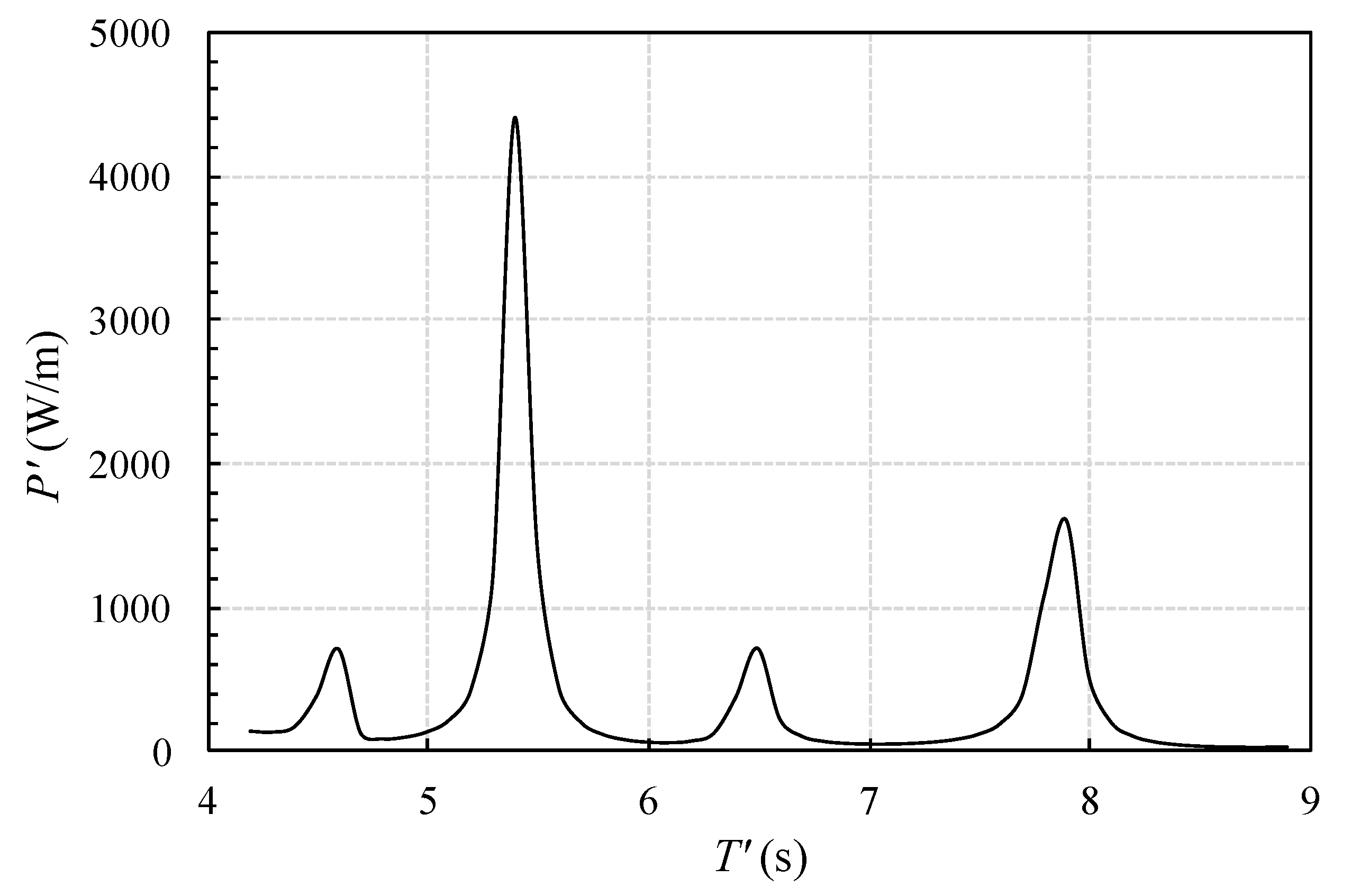
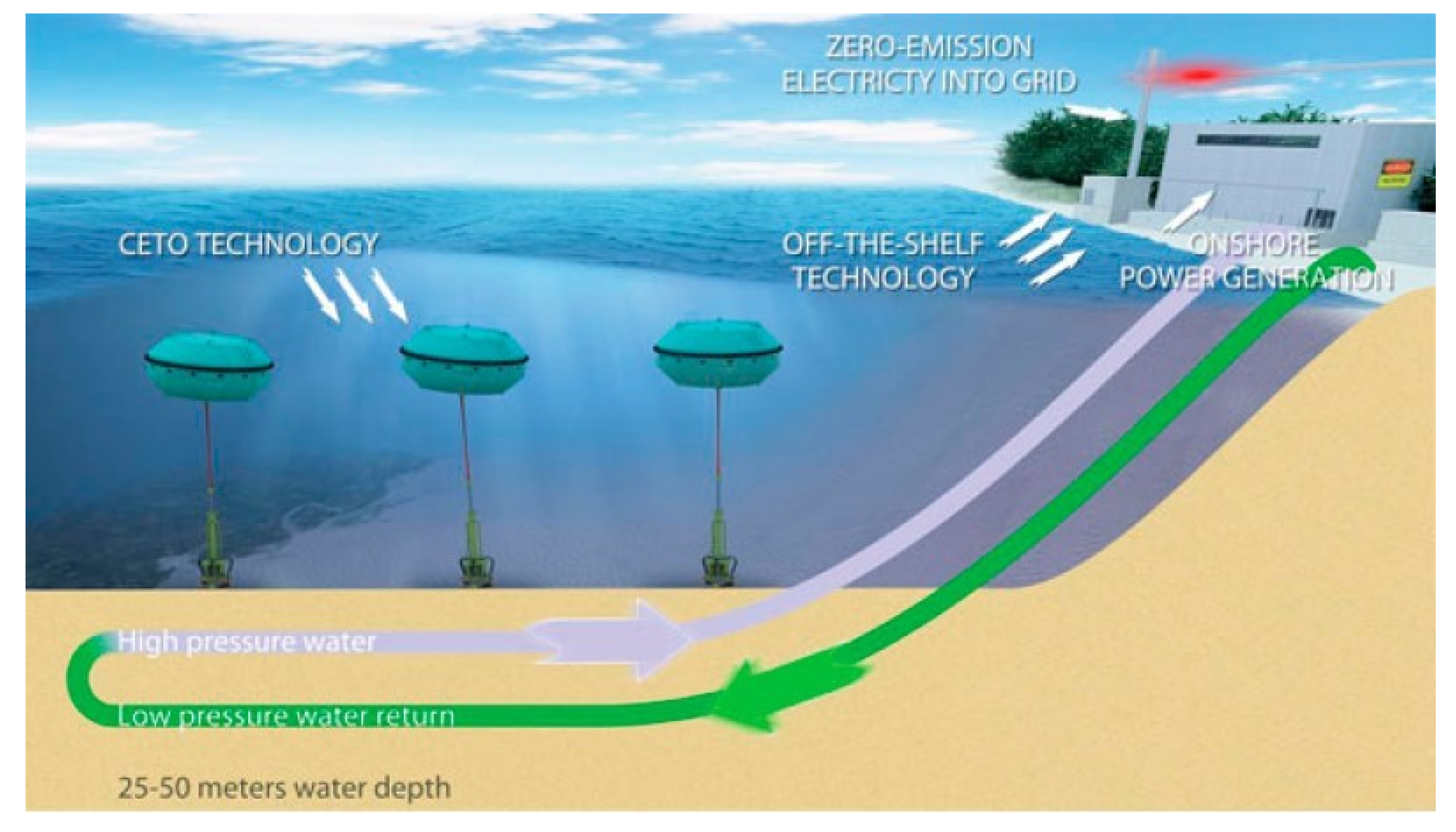
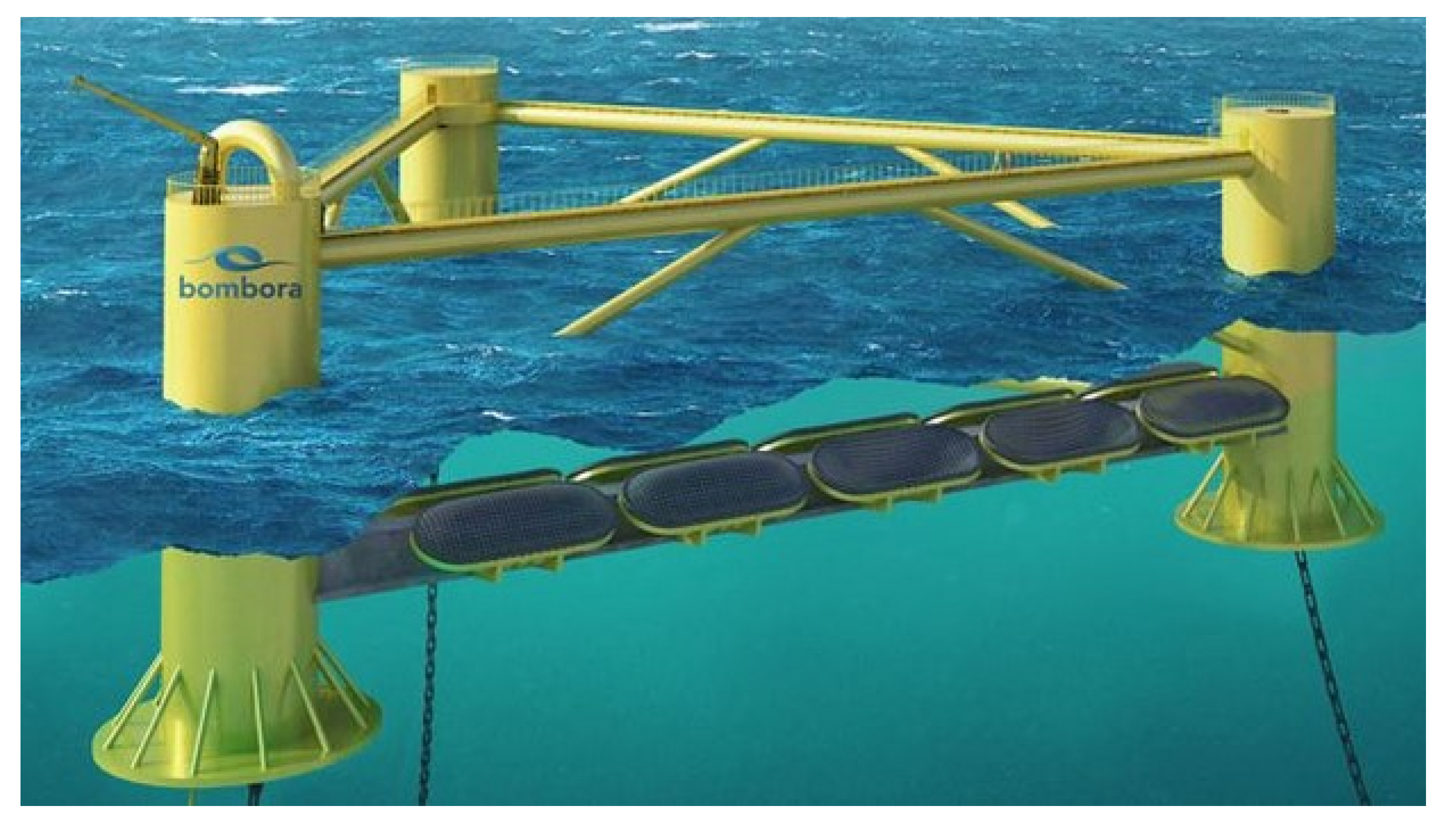
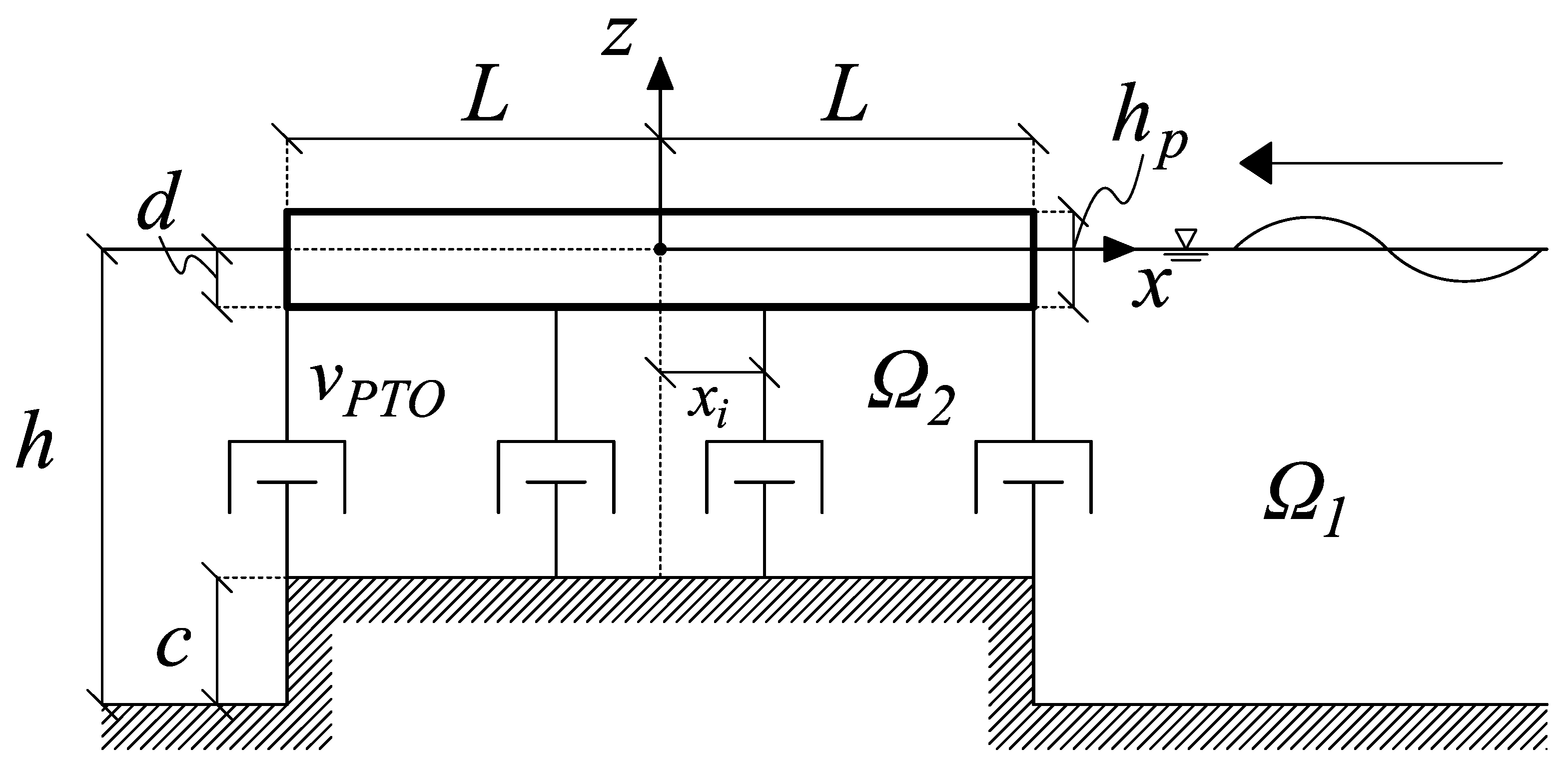
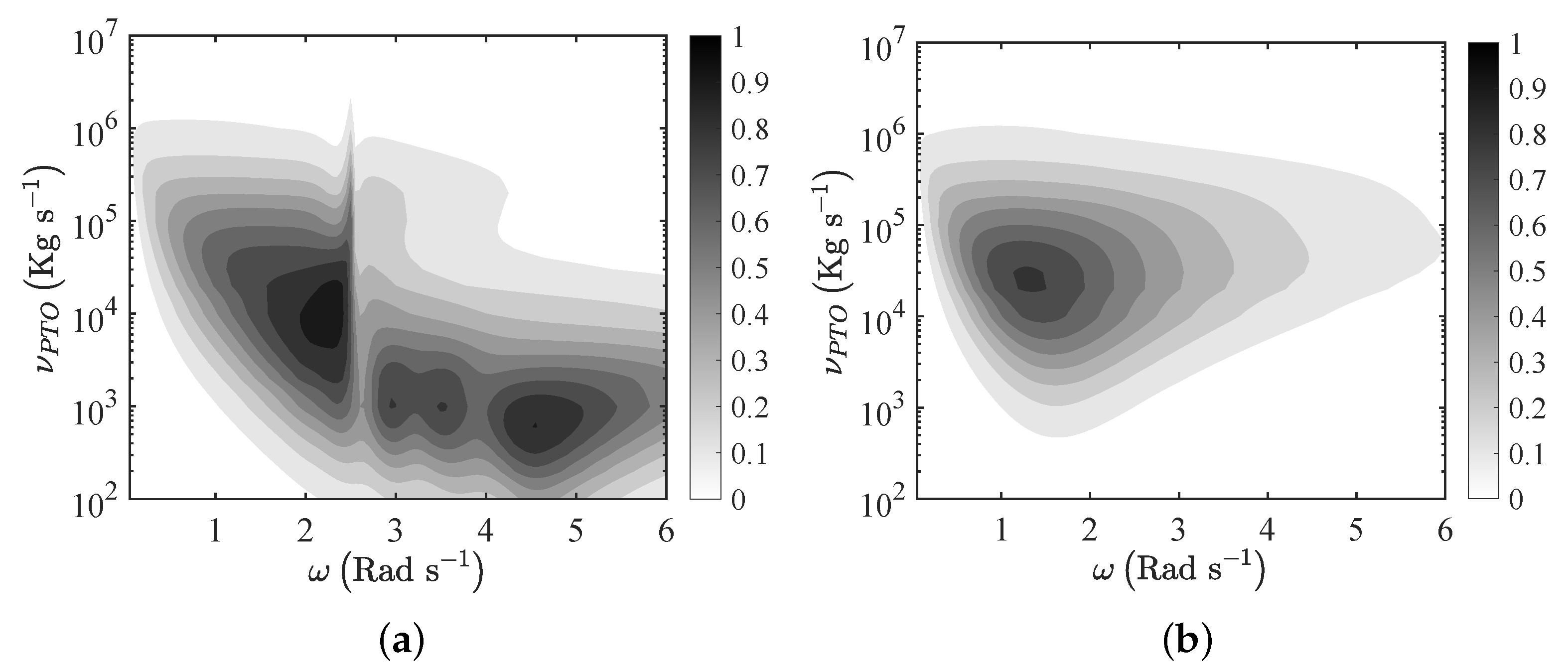
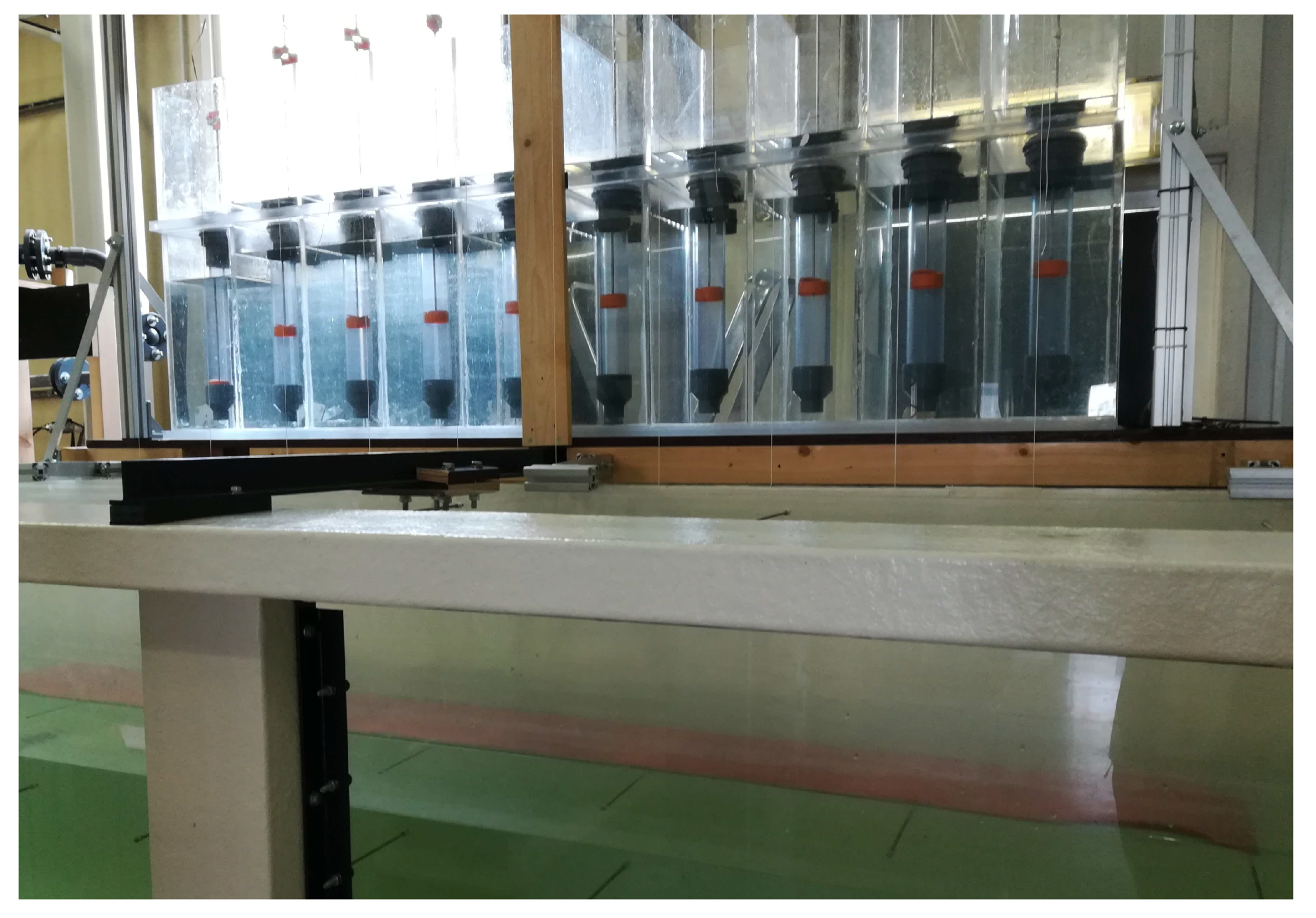
| Name | Country | Type | WEC | Stage | PerformanceIndicator |
|---|---|---|---|---|---|
| Mutriku | ESP | Breakwater | OWC | Operational | 296 kW (P) |
| REWEC3 | ITA | Breakwater | OWC | Operational | 26% (E) |
| OBREC | ITA | Breakwater | OTD | Operational | 2.5 kW (P) |
| Gates | UK | Breakwater | WAB | Conceptual | 0.7 () |
| Poseidon | DEN | Hybrid | WAB | Sea trials | 30 kW (P) |
| W2Power | NOR | Hybrid | WAB | Lab tests | n/a |
| Hybrid OWC | UK | Hybrid | OWC | Lab tests | 0.4 () |
| inSPIRE | AUS | Hybrid | DM | Conceptual | 4 MW (P) |
| Power Buoy | ITA | Offshore | WAB | Operational | n/a |
| ISWEC | ITA | Offshore | WAB | Operational | 50 kW (P) |
| Blue Star | UK | Offshore | WAB | Lab tests | n/a |
| EFHAS | JAP | Offshore | PE | Lab tests | 40 (P) |
| PWEC | UK | Offshore | PE | Conceptual | 4 (P) |
| DPP | AUS | Desalination | WAB | Operational | n/a |
| Odysée | CAN | Desalination | WAB | Demonstration | n/a |
| Saros | USA | Desalination | WAB | Demonstration | n/a |
| CETO | AUS | Microgrid | WAB | Operational | 1 MW (P) |
| UniWave200 | AUS | Microgrid | OWC | Demonstration | 200 kW (P) |
| Ccell | UK | Aquaculture | WAB | Lab tests | n/a |
| AWS-III | UK | Flexible | DM | Sea trials | 2.4 MW (P) |
| mWave | AUS-UK | Flexible | DM | Sea trials | 1.5 MW (P) |
| Anaconda | UK | Flexible | BW | Lab tests | 1.5 () |
| S3 | FRA | Flexible | EAP | Lab tests | n/a |
| Wave Carpet | USA | Flexible | DM | Lab tests | 45 kW (P) |
| Air bag | UK | Flexible | DM | Lab tests | 0.9 m (W) |
| Floater | UK | Flexible | FB | Lab tests | 0.26 () |
Publisher’s Note: MDPI stays neutral with regard to jurisdictional claims in published maps and institutional affiliations. |
© 2021 by the authors. Licensee MDPI, Basel, Switzerland. This article is an open access article distributed under the terms and conditions of the Creative Commons Attribution (CC BY) license (https://creativecommons.org/licenses/by/4.0/).
Share and Cite
Renzi, E.; Michele, S.; Zheng, S.; Jin, S.; Greaves, D. Niche Applications and Flexible Devices for Wave Energy Conversion: A Review. Energies 2021, 14, 6537. https://doi.org/10.3390/en14206537
Renzi E, Michele S, Zheng S, Jin S, Greaves D. Niche Applications and Flexible Devices for Wave Energy Conversion: A Review. Energies. 2021; 14(20):6537. https://doi.org/10.3390/en14206537
Chicago/Turabian StyleRenzi, Emiliano, Simone Michele, Siming Zheng, Siya Jin, and Deborah Greaves. 2021. "Niche Applications and Flexible Devices for Wave Energy Conversion: A Review" Energies 14, no. 20: 6537. https://doi.org/10.3390/en14206537
APA StyleRenzi, E., Michele, S., Zheng, S., Jin, S., & Greaves, D. (2021). Niche Applications and Flexible Devices for Wave Energy Conversion: A Review. Energies, 14(20), 6537. https://doi.org/10.3390/en14206537









